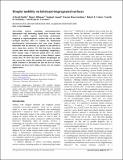| dc.contributor.author | Dhiman, Rajeev | en_US |
| dc.contributor.author | Anand, Sushant | en_US |
| dc.contributor.author | Reza-Garduno, Ernesto | en_US |
| dc.contributor.author | Cohen, Robert E. | en_US |
| dc.contributor.author | McKinley, Gareth H. | en_US |
| dc.contributor.author | Varanasi, Kripa K | en_US |
| dc.contributor.author | Smith, Jonathan David, S.M. Massachusetts Institute of Technology | en_US |
| dc.date.accessioned | 2013-06-06T14:48:02Z | |
| dc.date.available | 2013-06-06T14:48:02Z | |
| dc.date.issued | 2012-12 | |
| dc.date.submitted | 2012-09 | |
| dc.identifier.issn | 1744-683X | |
| dc.identifier.issn | 1744-6848 | |
| dc.identifier.uri | http://hdl.handle.net/1721.1/79068 | |
| dc.description.abstract | Non-wetting surfaces containing micro/nanotextures impregnated with lubricating liquids have recently been shown to exhibit superior non-wetting performance compared to superhydrophobic surfaces that rely on stable air–liquid interfaces. Here we examine the fundamental physico-chemical hydrodynamics that arise when droplets, immiscible with the lubricant, are placed on and allowed to move along these surfaces. We find that these four-phase systems show novel contact line morphology comprising a finite annular ridge of the lubricant pulled above the surface texture and consequently as many as three distinct 3-phase contact lines. We show that these distinct morphologies not only govern the contact line pinning that controls droplets' initial resistance to movement but also the level of viscous dissipation and hence their sliding velocity once the droplets begin to move. | en_US |
| dc.description.sponsorship | United States. Defense Advanced Research Projects Agency. Young Faculty Award | en_US |
| dc.description.sponsorship | Massachusetts Institute of Technology. Energy Initiative | en_US |
| dc.description.sponsorship | National Science Foundation (U.S.). CAREER Award (0952564) | en_US |
| dc.language.iso | en_US | |
| dc.publisher | Royal Society of Chemistry, The | en_US |
| dc.relation.isversionof | http://dx.doi.org/10.1039/C2SM27032C | en_US |
| dc.rights | Creative Commons Attribution-Noncommercial-Share Alike 3.0 | en_US |
| dc.rights.uri | http://creativecommons.org/licenses/by-nc-sa/3.0/ | en_US |
| dc.source | MIT web domain | en_US |
| dc.title | Droplet mobility on lubricant-impregnated surfaces | en_US |
| dc.type | Article | en_US |
| dc.identifier.citation | Smith, J. David et al. “Droplet Mobility on Lubricant-impregnated Surfaces.” Soft Matter 9.6 (2013): 1772. | en_US |
| dc.contributor.department | Massachusetts Institute of Technology. Department of Chemical Engineering | en_US |
| dc.contributor.department | Massachusetts Institute of Technology. Department of Mechanical Engineering | en_US |
| dc.contributor.department | Massachusetts Institute of Technology. Laboratory for Manufacturing and Productivity | en_US |
| dc.contributor.department | Massachusetts Institute of Technology. School of Engineering | en_US |
| dc.contributor.mitauthor | Smith, Jonathan David | en_US |
| dc.contributor.mitauthor | Dhiman, Rajeev | en_US |
| dc.contributor.mitauthor | Anand, Sushant | en_US |
| dc.contributor.mitauthor | Reza-Garduno, Ernesto | en_US |
| dc.contributor.mitauthor | Cohen, Robert E. | en_US |
| dc.contributor.mitauthor | McKinley, Gareth H. | en_US |
| dc.contributor.mitauthor | Varanasi, Kripa K. | en_US |
| dc.relation.journal | Soft Matter | en_US |
| dc.eprint.version | Author's final manuscript | en_US |
| dc.type.uri | http://purl.org/eprint/type/JournalArticle | en_US |
| eprint.status | http://purl.org/eprint/status/PeerReviewed | en_US |
| dspace.orderedauthors | Smith, J. David; Dhiman, Rajeev; Anand, Sushant; Reza-Garduno, Ernesto; Cohen, Robert E.; McKinley, Gareth H.; Varanasi, Kripa K. | en_US |
| dc.identifier.orcid | https://orcid.org/0000-0002-6846-152X | |
| dc.identifier.orcid | https://orcid.org/0000-0002-1480-1840 | |
| dc.identifier.orcid | https://orcid.org/0000-0001-8323-2779 | |
| dc.identifier.orcid | https://orcid.org/0000-0003-1085-7692 | |
| dspace.mitauthor.error | true | |
| mit.license | OPEN_ACCESS_POLICY | en_US |
| mit.metadata.status | Complete | |
